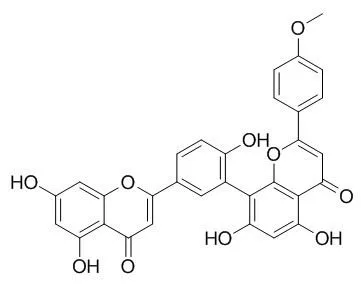| In vitro: |
| Planta Med. 2012 May;78(7):672-7. | | Biflavonoids of Dacrydium balansae with potent inhibitory activity on dengue 2 NS5 polymerase.[Pubmed: 22411725] | In order to find new molecules for antiviral drug design, we screened 102 ethyl acetate extracts from New-Caledonian flora for antiviral activity against the dengue 2 virus RNA-dependant RNA polymerase (DV-NS5 RdRp).
METHODS AND RESULTS:
The leaf extract of Dacrydium balansae, which strongly inhibited the DV-NS5, was submitted to bioguided fractionation. Four biflavonoids ( 1- 4), three sterols ( 5- 7), and two stilbene derivatives ( 8- 9) were identified and evaluated for their antiviral potential on the DV-NS5 RdRp. Biflavonoids appeared to be potent inhibitors of DV-NS5 RdRp with IC (50)s between 0.26 and 3.12 µM. Inhibitory activity evaluations against the RNA polymerase from other Flaviviridae viruses allowed us to conclude that these compounds are specific inhibitors of the DV RNA polymerase. The strongest inhibitions were observed with hinokiflavone ( 4), but Podocarpusflavone A ( 2) is the strongest noncytotoxic inhibitor of the DV-NS5 and it also displayed polymerase inhibitory activity in a DV replicon.
CONCLUSIONS:
A preliminary structure-activity relationship study (SARs) revealed the necessity of the biflavonoid skeleton, the influence of number and position of methoxylations, and the importance of a free rotation of the linkage between the two apigenin monomers of the biflavonoids. To the best of our knowledge, Podocarpusflavone A ( 2) is the strongest noncytotoxic non-nucleotide molecule exhibiting a specific inhibitory activity against the RNA polymerase domain of DV-NS5 and thus is promising for chemotherapy development against dengue fever. | | Ann Trop Med Parasitol. 2007 Jan;101(1):23-30. | | Antimalarial and vasorelaxant constituents of the leaves of Allanblackia monticola (Guttiferae).[Pubmed: 17244407 ] |
METHODS AND RESULTS:
Phytochemical investigation of the leaves of Allanblackia monticola led to the isolation and characterisation of five prenylated xanthones [1,6-dihydroxy-3,7-dimethoxy-2-(3-methylbut-2-enyl)xanthone 1, alpha-mangostin 2, tovophyllin A 3, allanxanthone C 4 and 1,7-dihydroxy-3-methoxy-2-(3-methylbut-2-enyl)xanthone 5], two biflavonoid derivatives (amentoflavone 6 and Podocarpusflavone A 7) and one pentacyclic triterpene (friedelan-3-one 8). The structures of these compounds were established on the basis of homo- and hetero-nuclear, one- and two-dimensional, nuclear magnetic resonance. Compounds 2-8 and a crude methanolic extract of A. monticola leaves were each tested for antimalarial activity in vitro, using the chloroquine-sensitive F32 and chloroquine-resistant FcM29 strains of Plasmodium falciparum; the median inhibitory concentrations (IC(50)) recorded varied from 0.7 to 83.5 mug/ml. The cytotoxicities of the compounds and crude extract, against cultures of human melanoma cells (A375), were then investigated, and cytotoxicity/antimalarial IC(50) ratios of 0.6-16.75 were recorded.
CONCLUSIONS:
In tests involving aortic rings from guinea pigs, a crude extract of the leaves of A. monticola was found to induce concentration-dependent vasorelaxation, causing up to 82% and 42% inhibition of noradrenaline- and KCl-induced contractions, respectively. The corresponding values for compounds 2 and 6 when tested against noradrenaline-induced contractions were approximately 18% and 35%, respectively. |
|






 Cell. 2018 Jan 11;172(1-2):249-261.e12. doi: 10.1016/j.cell.2017.12.019.IF=36.216(2019)
Cell. 2018 Jan 11;172(1-2):249-261.e12. doi: 10.1016/j.cell.2017.12.019.IF=36.216(2019) Cell Metab. 2020 Mar 3;31(3):534-548.e5. doi: 10.1016/j.cmet.2020.01.002.IF=22.415(2019)
Cell Metab. 2020 Mar 3;31(3):534-548.e5. doi: 10.1016/j.cmet.2020.01.002.IF=22.415(2019) Mol Cell. 2017 Nov 16;68(4):673-685.e6. doi: 10.1016/j.molcel.2017.10.022.IF=14.548(2019)
Mol Cell. 2017 Nov 16;68(4):673-685.e6. doi: 10.1016/j.molcel.2017.10.022.IF=14.548(2019)